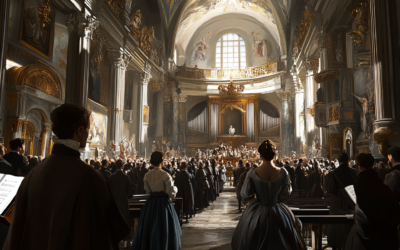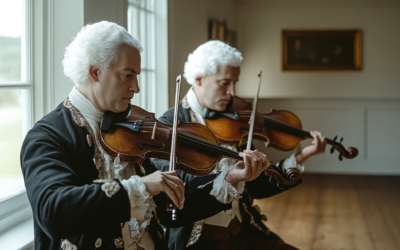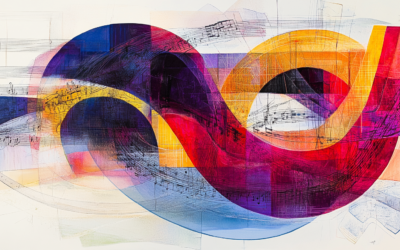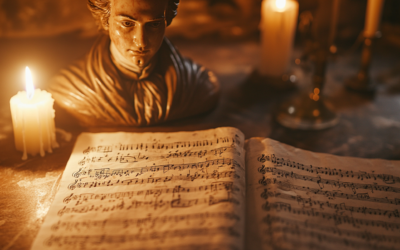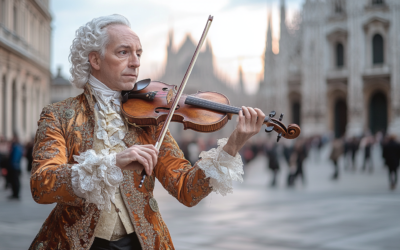The Myth of Mozart’s Sight-Reading Genius
A Closer Examination
In the 18th century, exaggerated accounts of Mozart’s abilities were as common as they were fantastical. Yet, detailed reports from figures like Daines Barrington and André Grétry reveal a far more human side of the prodigy, whose skills, impressive though they were, did not amount to the miraculous feats often attributed to him.
Mozart: The Fall of the Gods
This book offers a fresh and critical look at the life of Wolfgang Amadeus Mozart, challenging the myths that have surrounded him for centuries. We strip away the romanticised image of the “natural genius” and delve into the contradictions within Mozart’s extensive biographies. Backed by nearly 2,000 meticulously sourced citations, this work invites readers to explore a deeper, more complex understanding of Mozart. Perfect for those who wish to question the traditional narrative, this biography is a must-read for serious music lovers and historians.
"Even the most lauded prodigies sometimes hide a kernel of reality beneath layers of myth."
Mozart: The Fall of the Gods
Separating Fact from Fiction in 18th-Century Reports
In the concert posters promoting young Wolfgang Mozart, he was lauded as a prodigy capable of sight-reading even the most difficult pieces flawlessly. Such claims, often more fantastical than credible, warrant closer scrutiny. Two notable contemporary accounts diverge from the usual paternal praise or the laudatory articles seen in 18th-century newspapers. One is a scientific report from London, penned by Daines Barrington (1727–1800), a member of the Royal Society. The report, dating from June 1765, was finalized in 1769 and presented on February 15, 1770, a full five years after the original test.
Barrington was a multifaceted figure: a barrister, antiquarian, and naturalist with a penchant for ornithology and a fascination for musical prodigies. His book, a curious collection of studies ranging from the origins of turkeys to the melodiousness of birds, often employed flowery and exaggerated language. Perhaps Barrington’s fondness for child prodigies contributed to the surge in popularity of such marvels in England. He documented not only the Mozarts but also other youthful musicians like the Wesley brothers and William Crotch. Yet, his approach lacked scientific rigour, often relying on hearsay and questionable sources.
Barrington’s report on Mozart was no exception. In his experiment, he presented a manuscript duet, its composer unspecified, to test Mozart’s sight-reading skills. The piece was from Metastasio’s Demofoonte, arranged for two vocal parts and strings. Curiously, the vocal parts were written in the alto clef, which Barrington highlighted as if it were a major obstacle. Despite this build-up, Wolfgang executed the symphony introduction “masterfully,” as Barrington put it, then sang the upper vocal line while his father Leopold tackled the lower. Leopold faltered, eliciting disapproving looks from his son, who even corrected his mistakes. Barrington claimed that Wolfgang not only sang beautifully but also embellished the accompaniment with violin parts to enhance the musical effect.
A closer analysis reveals that the test was calibrated for both Mozarts, and Wolfgang, not surprisingly, outperformed his father. Stripping away the superlatives, we see that Wolfgang competently played the bass line with his left hand and added occasional violin parts with his right. Impressive for an eight-year-old, certainly, but not the miracle Barrington made it out to be. His comparison of the duet’s difficulty to reading ancient texts like Etruscan and Greek reveals his musical naivety. Instead of a supernatural feat, the performance was a well-practiced skill honed by Leopold to impress the general public.
Even more telling is a different account from André Ernest Modeste Grétry (1741–1813), a professional musician who tested Mozart in Geneva. When Leopold boasted of his son’s sight-reading prowess, Grétry composed a challenging sonata movement in B-flat major. Mozart played it, yet replaced several difficult passages with his own improvisations. The audience, except Grétry, was in awe. Grétry’s skepticism highlighted Wolfgang’s reliance on improvisation and lack of systematic study, a strategy that gave the illusion of mastery.
Mozart’s ability to read music, while exceptional for his age, fell short of true sight-reading as it’s defined today: a flawless, spontaneous execution of written music, requiring years of rigorous training and experience. Grétry’s observations dispel the myth of Mozart’s innate genius, pointing instead to his reliance on quick-thinking and a boldness typical of children.
You May Also Like
The Questionable Attribution of Mozart’s Offertorium K.34
Attributing Offertorium K.34 to Mozart is not just misleading, it reflects the careless methods used by 19th-century scholars to inflate his legacy. Without an autograph or solid evidence, this work should not be considered part of his output.”
The Mysterious Case of Mozart’s Duets: An Unfinished Story
Mozart’s string duets have long been shrouded in mystery, from his father’s heavy influence in 1768 to his supposed act of charity for a dying Michael Haydn in 1783. These unfinished works reveal more about the composer’s life and struggles than they do about his musical genius.
The Misattribution of Mozart’s K.2 89a (K.6 73i): A Questionable Canon
K.2 89a (K.6 73i), attributed to Mozart, is riddled with issues—missing voices, incomplete harmonies, and even the absence of text. Should this piece really be in his catalogue?
The Borrowed Simplicity: Mozart’s Canons K.555, K.557, and K.562
The canons K.555, K.557, and K.562, often overlooked for their simplicity, reveal striking similarities with the works of Antonio Caldara. These three pieces, dated 1788, demonstrate how Mozart adapted and simplified Caldara’s contrapuntal structures, masking his influences while reflecting the galant style of the era.
Simplicity, Errors, and the Myth of Perfection
Mozart’s canons are not as complex as often claimed, with notable errors in K.553 and K.554, and the myth of “V’amo di cuore teneramente” K.348 being debunked.
The Uncertain Origins of Mozart’s Early String Quartets
Mozart’s so-called “Milanese Quartets” (K.155, 158, and 159) have long been subject to debate, primarily due to their ambiguous instrumentation and structural weaknesses. Were these works part of a larger series of orchestral divertimenti, hastily repurposed as string quartets? The answer remains elusive, reflecting the young composer’s struggles to find his own voice.


